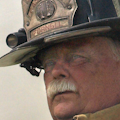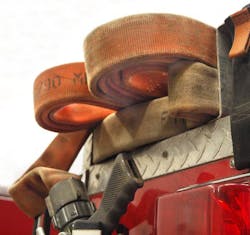Get a Handle On It
Last fall, I had the chance to pull the initial attack hose line on a fully involved combine fire. For you city folks, that's the big green or red machine driving around behind the barn that costs $300,000 and harvests beans and corn.
Because when things go wrong, these things are usually out in the fields, our first-in rig was a 4-wheel drive brush truck. While we normally are pretty particular on how we finish off the hose loads on our pumpers' structural attack lines, the 1-1/2" line on this rig was just folded into the shallow hose bed on the brush rig accordion style. Well, the line came off, as it always does, but when we were packing it back up, I thought, boy, it sure needed some type of handle to help in getting it off.
Because of the shallow and wide design of the bed, it is best to pack the hose on edge. We thought the simplest solution in this case, was to finish the load by packing it in a backwards horseshoe style, which gives us two loops of about 60 to 70 feet each that are easy to pull and deploy by a single firefighter.
Thinking about it later, I realized that there are a few lessons to be learned from this event.
- You need to take a look at all your hose beds, whether they are the first line off the engine or a seldom used hose packed on the tanker or brush rig, and make sure that they can be pulled easily without having to pick at and throw off individual folds of hose.
- Make a handle. It can be a simple loop of hose or multiple loops. A handle makes it easier for firefighters to get enough hose off the rig as they head to the fire.
- Make it easy for the firefighter to take some working line with them. A single handle helps, but if it is placed properly or the handle is made up of multiple folds of hose, all the better.
Sometimes the simplest things, or lack thereof, can slow us down or even worse, get us into trouble when preparing to make an attack. Next time you are having a slow day, take a look under the flaps and see if maybe you can make a difference.
About the Author

Capt. Dave Fornell
Captain David P. Fornell is active as a line officer in the Casstown Community Fire Department, Casstown, OH, protecting 88 square miles of rural area in and around Casstown, Ohio. He formerly held the rank of Captain of the Beckerle & Company, Hose Company, Engine #9 of the Danbury, Connecticut fire department protecting a busy city of 85,000, and was the full time Chief of the Westchester, Illinois fire department, a suburb of Chicago. He started his career as a firefighter in the Addison, IL Fire Department, located about 20 miles west of Chicago. Capt. Fornell is a certified fire service instructor specializing in engine company operations, company officer development and fire ground safety courses and he holds the rank of Honorary Battalion Chief of the FDNY. He is the author of "FIRE STREAM MANAGEMENT HANDBOOK" along with an accompanying training video published by Fire Engineering Books and Videos, and served seven years as the Executive Editor of FIRE APPARATUS magazine. Capt. Fornell has written articles for FIRE ENGINEERING and FIREHOUSE magazines in the U.S., FIRE AND RESCUE and MILITARY FIREFIGHTER in the United Kingdom. He has hosted the rural water supply, engine company operations and line officer training segments of "THE FIRST LINE SUPERVISOR" for the FETN television network.
